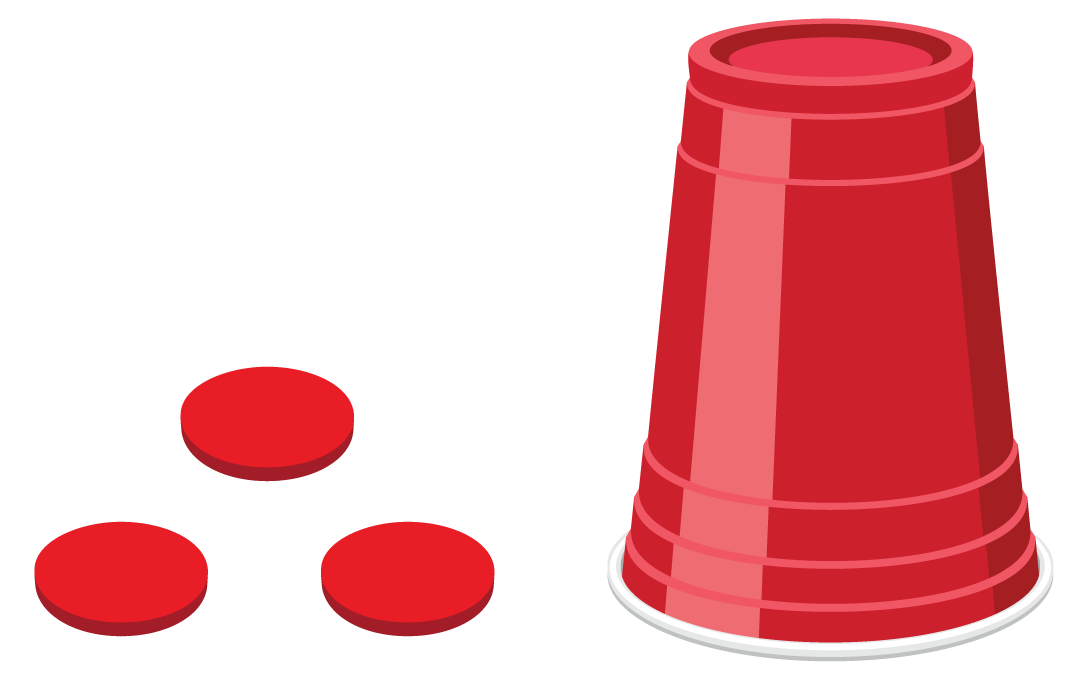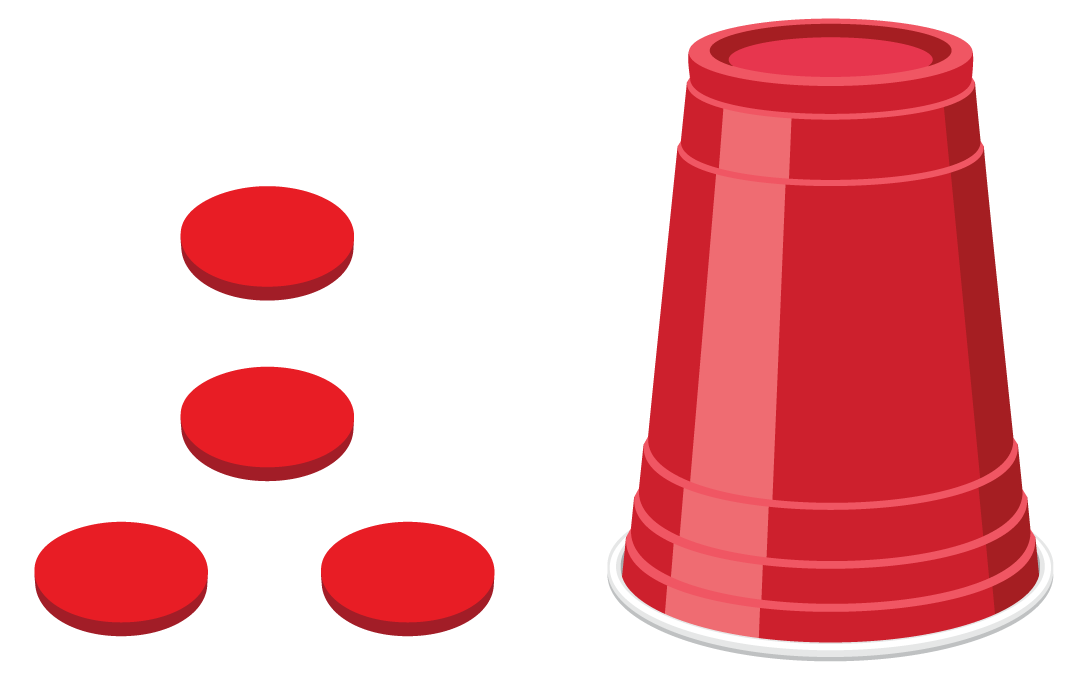Lesson 8
Shake, Spill, and Cover
Warm-up: Choral Count: Count On From 10 (10 minutes)
Narrative
Launch
- "Count by 1, starting at 10."
- Record as students count.
- Stop counting and recording at 40.
Activity
- "What patterns do you see?"
- 1–2 minutes: quiet think time
- Record responses.
Student Response
For access, consult one of our IM Certified Partners.
Activity Synthesis
- "How did you know what number comes after 10? 19? 29?"
Activity 1: Introduce Shake and Spill, Cover (20 minutes)
Narrative
The purpose of this activity is for students to learn stage 4 of the Shake and Spill center. Students know the total number of counters and the number of red counters and have to determine the number of yellow counters. Students may use any method they choose. Students may count up from the red counters to the total using objects or drawings. Some students may subtract the number of red counters from the total. During the activity, the teacher collects and displays 4–5 student combinations of 10 from round 1 to display during the synthesis. It is important to display some equations with the total before the equal sign. In the synthesis, students relate the equations to the Shake and Spill game by circling the part of the equation that says how many yellow counters are under the cup (MP2).
Supports accessibility for: Conceptual Processing, Visual-Spatial Processing
Required Materials
Materials to Gather
Materials to Copy
- Shake and Spill Stage 4 and 5 Recording Sheet (G1 and 2)
Required Preparation
- Each group of 2 needs 10 two-color counters and a cup (at least 8 oz).
Launch
- Groups of 2
- Give each group a cup, 10 two-color counters, recording sheets and access to 10-frames.
- Display the launch image.
- "We are going to learn a new way to play Shake and Spill. Let's play one round together. I need eight counters. Let's count together as I put the counters in the cup."
- Count out eight counters.
- “I’m going to shake and spill the counters. I am going to cover up the yellow counters with my cup before my partner sees them. Close your eyes. Keep them closed until I tell you."
- Shake the counters in the cup, spill the counters, and cover the yellow counters with your cup.
- "Open your eyes. How many yellow counters are under the cup? How do you know?”
- 30 seconds: quiet think time
- 1 minute: partner discussion
- Share responses and demonstrate recording the number of counters and the equation on the recording sheet.
Activity
- "For the first game you will use 10 counters and record in your book. After the first game, you can choose how many counters you want to use, and record on the separate recording sheet."
- 10 minutes: partner work time
- As students play, collect 5–6 combinations and equations from round 1 and record them on a chart.
Student Facing
| total number of counters | red counters |
yellow counters |
equations |
|---|---|---|---|
Round 1:
| total number of counters | red counters |
yellow counters |
equations |
|---|---|---|---|
| 10 | |||
| 10 | |||
| 10 | |||
| 10 | |||
| 10 | |||
| 10 |
Student Response
For access, consult one of our IM Certified Partners.
Activity Synthesis
- Display 5–6 equations.
- “What does each part of the equation represent?”
- If needed, “Which part of the equation shows the answer to the question? How do you know?” (We had to find out how many yellow counters were under the cup, so the number that represents yellow.)
- “Work with your partner to draw a box around the answer in each equation.”
Activity 2: Shake and Spill, Cover Problems (15 minutes)
Narrative
The purpose of this activity is for students to represent and solve Put Together/Take Apart, Addend Unknown story problems based on the game they played in the previous activity. As students write their equations, they may write the total before the equal sign or after the equal sign. They may also use the “add in any order” property to write different equations. During the activity synthesis, students relate the equation back to the story problem, identify the missing addend, and put a box around it.
Students use two-color counters during lesson synthesis.
Advances: Listening, Speaking
Required Materials
Materials to Gather
Launch
- Groups of 2
- Give students access to 10-frames and two-color counters.
Activity
- “Solve these problems about some rounds of Shake and Spill, Cover. Write an equation that matches each problem. Be ready to explain your thinking in a way that others will understand.”
- 6 minutes: independent work time
- 3 minutes: partner discussion
- Monitor for students who write these equations for problem 3:
- \(6 + 4 = 10\)
- \(4 + 6 =10\)
- \(10 = 6 + 4\)
Student Facing
-

There are 9 counters total.
How many counters are under the cup?Equation: ____________________________
-

There are 7 counters total.
How many counters are under the cup?Equation: ____________________________
-
There are 6 counters outside the cup.
Some of the counters are under the cup.
There are 10 counters total.
How many counters are under the cup?Equation: ____________________________
-
There are 3 counters outside the cup.
Some of the counters are under the cup.
There are 8 counters total.
How many counters are under the cup?Equation: ____________________________
Student Response
For access, consult one of our IM Certified Partners.
Advancing Student Thinking
- "How did you find out how many are under the cup?"
- "How can you use two-color counters to check?"
Activity Synthesis
- Invite previously identified students to share.
- “How does each number in the equation represent the story?” (10 total counters, 6 red counters, 4 yellow counters.)
- “Which part of the equation represents the answer to the question? How do you know?” (4. It’s the number of hidden counters that we have to find.)
- Display \(10 = 6 + \boxed{4}\).
- “Work with your partner to put a box around the part of each equation that represents the number of counters you found.”
Lesson Synthesis
Lesson Synthesis
Display \( 5 +\boxed{\phantom{3}} = 8\)
“Today we played a game where we had to find out how many counters were under our cup. We wrote equations to match the counters. How could this equation match the counters in a round of Shake and Spill, Cover?” (There are 5 red counters showing. Some yellow counters are under the cup. There are 8 total counters.)
“Find the number that makes the equation true. Show how you know.” (3. I counted on from 5: 6, 7, 8. I put down 5 red counters, then added yellow counters until I got to 8. There are 3 yellow counters.)
“When we know one of the addends in an equation, we can find the other by thinking about how many more we need to get to the total."
Cool-down: Clare Plays Shake and Spill, Cover (5 minutes)
Cool-Down
For access, consult one of our IM Certified Partners.